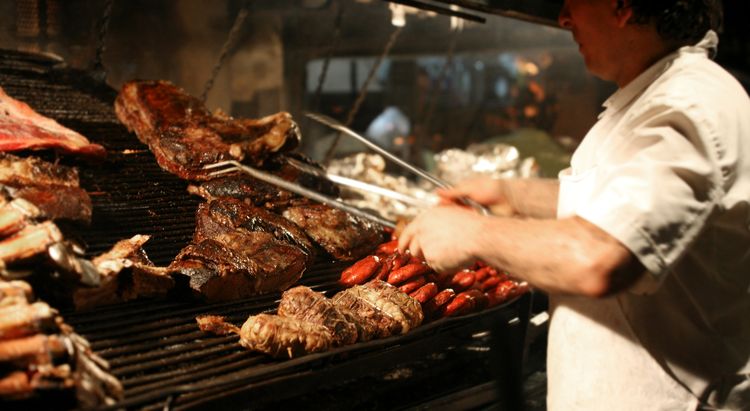-
2026/05/26
Boston(BOS) -
2026/05/31
Buenos Aires
(Updated: September, 22, 2025 07:07)
Argentina Travel Tips and Information
Official Name
Argentine Republic
Capital
Buenos Aires
Population
Country Code
Approximately 45.7 million
AR
Country Code (international calls)
+54
The flight time to Argentina is approximately 11~13 hours. Check the climate, currency, religion, manners, other information of Argentina below. Wishing you pleasant travels to Argentina.
It is located in the Southern Hemisphere. It lies at the southern tip of South America, sharing a border with Chile. Covering an area of approximately 2.79 million square kilometers, Argentina ranks as the eighth largest country in the world.
Compare Airfares for Flights to Argentina
Compare Airfares for Flights to Argentina
Compare Airfares for Flights to Argentina
Local Climate / Weather
Argentina's climate varies significantly across its expansive regions, offering travelers a diverse experience year-round. The country's northern areas feature a subtropical climate with hot, humid summers and mild winters, ideal for those seeking warmth. In contrast, southern Argentina, particularly Patagonia, has a cooler, temperate climate, with summer from December to February offering ideal conditions for outdoor exploration.
Currency & Tipping
Currency
In Argentina, the official currency is the Argentine Peso (ARS), and knowing its denominations and exchange process is essential for travelers. Currency exchanges are available at airports, banks, and authorized exchange centers, and it’s advisable to bring U.S. dollars for easier exchange at favorable rates. Credit and debit cards are widely accepted, especially in urban areas, but cash remains useful, particularly in smaller towns and markets.
Tipping
A 10% tip is generally customary in restaurants if service isn't included, while small tips for taxi drivers and hotel staff are appreciated but not mandatory. Travelers should carry smaller bills for tipping convenience. Familiarizing oneself with these practices ensures smooth transactions and shows appreciation for local hospitality.
Useful Travel Information

Voltage & Electrical Outlets
Argentina operates on 220 volts with Type C and Type I outlets, so bring an appropriate adapter and voltage converter if needed.

Internet Connectivity
For internet access, Argentina has a reliable network, with major local carriers like Claro, Movistar, and Personal providing prepaid SIM cards and mobile data plans widely available at airports and local shops.
Water for Consumption (Drinking Water)
Drinking tap water is generally safe in major cities like Buenos Aires, but bottled water is recommended for rural areas. Familiarizing yourself with these essentials will help you travel Argentina comfortably and stay connected.
Culture, Religion & Social Etiquette
Culture
Argentina is known for its passionate and expressive culture, with music and dance, particularly the famous tango, at the heart of social gatherings. Argentinians are deeply proud of their national identity, and cultural festivals such as the Carnaval, celebrated in February, showcase lively parades and traditional costumes. Additionally, Argentina’s culinary culture, centered around asado (barbecue), is an experience not to be missed, providing a social ritual that brings families and friends together over shared meals. Exploring local markets or attending a traditional gaucho festival offers Travelers an authentic glimpse into Argentina's cultural landscape.
Religion
Argentina is predominantly Catholic, with around 62% of the population identifying with the faith. This is reflected in the country’s beautiful colonial churches and the grand festivals celebrating saints, which add a spiritual dimension to its cultural tapestry. While Catholicism plays a significant role, Argentina also respects religious diversity, with various communities practicing Judaism, Islam, and Protestantism.
Social Etiquette
Argentinians are known for their friendliness and value warm social interactions. A common greeting is a kiss on the cheek, even among acquaintances. When invited to a home, it's customary to bring a small gift, such as a bottle of wine or sweets, and arriving fashionably late is generally acceptable. Public displays of affection and casual dress are common, especially in relaxed settings. For travelers, understanding these social norms can lead to more meaningful interactions and a deeper appreciation of Argentina’s welcoming spirit.
Food Culture
Argentina offers travelers a vibrant and hearty food culture that brings together rich flavors and local traditions, providing a delightful culinary journey. Known for its world-famous beef, Argentine cuisine celebrates asado, a traditional barbecue that’s central to social gatherings. You can expect to enjoy tender, flavorful cuts of meat grilled over an open flame, often accompanied by chimichurri sauce, a tangy blend of herbs and garlic. Street food in Argentina is also a must-try, with empanadas taking the spotlight. These hand-held pastries, filled with beef, chicken, or cheese, make for a delicious and convenient snack while exploring the city streets. Another favorite is choripán, a flavorful sausage sandwich served with chimichurri. To experience authentic Argentinian dining, visitors can explore renowned local restaurants like Don Julio in Buenos Aires, where the asado experience reaches new heights, or La Cabrera, known for its diverse cuts of meat and warm ambiance. For those seeking a taste of Argentina’s famous wines, visiting a parrilla (steakhouse) with a curated wine list from Mendoza is highly recommended. Beyond meat dishes, travelers will find Argentine-style pizza and pasta, showcasing the country’s Italian influence. Exploring these flavors offers Travelers a unique experience in Argentina’s food culture, blending tradition and innovation in every bite.
Major Tourist Attractions & UNESCO World Heritage Sites
Major Tourist Attractions
1. Iguazu Falls Located in the Iguazu National Park on the border between Argentina and Brazil, Iguazu Falls is one of the most awe-inspiring natural wonders in the world. Known for its impressive 275 cascades, the falls offer activities like scenic boat rides, guided jungle tours, and walkway treks for spectacular views. A visit to the Devil’s Throat, the park’s highest and most powerful waterfall, is a must. The surrounding rainforest, filled with exotic wildlife, adds a magical touch to the experience. 2. Buenos Aires: The Paris of South America Argentina’s capital, Buenos Aires, is a vibrant city rich in European-inspired architecture, colorful neighborhoods, and lively tango performances. Visitors can explore the historic district of San Telmo, marvel at the stunning architecture of the Casa Rosada, or stroll along Caminito in the La Boca neighborhood. A visit to Teatro Colón, a renowned opera house, is highly recommended. Travelers can also indulge in Argentina’s famous steak and empanadas while immersing in the city's energetic nightlife. 3. Mendoza: Wine Country For travelers who enjoy wine, Mendoza is the ideal destination. Famous for its Malbec wine, the region offers scenic vineyard tours and wine tastings with the stunning Andes Mountains as a backdrop. Visitors can also enjoy outdoor activities such as hiking, mountain biking, and rafting. Each March, the Mendoza Wine Harvest Festival celebrates the grape harvest, making it a fantastic cultural experience for those visiting during this period.
UNESCO World Heritage Sites
1.Patagonia and Los Glaciares National Park Located in southern Argentina, Patagonia is home to the Los Glaciares National Park, a UNESCO World Heritage Site. The park’s main attraction, the Perito Moreno Glacier, offers the unique experience of glacier trekking and boat tours that bring visitors close to the stunning ice formations. Other activities include hiking the Fitz Roy Range, visiting the picturesque town of El Calafate, and exploring the vast landscapes of the Patagonian wilderness. 2.Quebrada de Humahuaca A UNESCO World Heritage Site, Quebrada de Humahuaca is a striking valley in northwestern Argentina with vibrant, colorful mountains. The region’s multi-colored hills, such as the Hill of Seven Colors in Purmamarca, make for beautiful sightseeing and photography spots. Visitors can also explore indigenous villages, ancient Incan ruins, and attend local festivals that showcase Argentina’s rich cultural heritage. The area’s unique geological formations and cultural depth offer a distinct contrast to other Argentinian landscapes. 3. Valdés Peninsula This UNESCO-listed site on Argentina’s Atlantic coast is a paradise for nature enthusiasts. It is one of the world’s best places to observe marine wildlife, including whales, orcas, sea lions, and Magellanic penguins. Eco-tours and whale-watching excursions are popular, especially between June and December. The Valdés Peninsula offers unforgettable wildlife encounters for travelers, with the chance to learn about Argentina’s commitment to conservation. These destinations make Argentina an incredible destination for travelers, offering a mix of vibrant city life, awe-inspiring natural landscapes, and immersive cultural experiences. With this blend of historic and natural beauty, travelers are sure to create memorable experiences in Argentina.
Travel FAQs
Is Tagalog or English widely understood in Argentina?
While Spanish is the official language in Argentina, English is understood in some tourist areas, especially those influenced by tourism or international business.
What’s the best time of year to visit Argentina?
The best times to visit Argentina are during the South American summer, from December to February, or in spring, from September to November. Argentina offers diverse attractions and experiences throughout the year, making it a year-round destination for travelers.
How safe is Argentina? Are there any precautions to keep in mind?
Argentina is generally safe, but it’s advisable to stay vigilant in crowded urban areas due to occasional petty crimes like pickpocketing. Rural areas tend to have a lower crime rate, though standard safety precautions are still recommended.
What is the most popular airport for flights to Argentina?
Ezeiza International Airport, located near Buenos Aires, Argentina’s capital, is the main and most popular airport for international travelers arriving in the country.
What are the current COVID-19 entry requirements for Argentina?
Current COVID-19 entry requirements may include completing a health declaration form and, in some cases, presenting proof of vaccination or a recent negative COVID-19 test, depending on the latest regulations.




